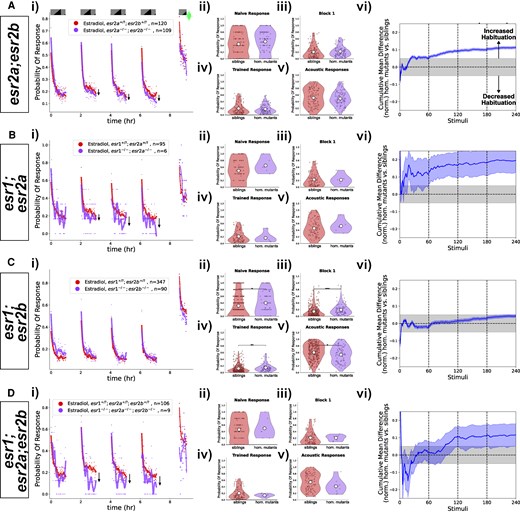Fig. 4 Double and triple mutant combinations of esr1, esr2a, and esr2a do not show habituation deficits after treatment with estradiol. A) Homozygous esr2a(−/−);esr2b(−/−) double mutants (n = 109 fish) do not show impaired habituation relative to double heterozygous or homozygous sibling controls ((+/?);(+/?), n = 120 fish). B) Homozygous esr1(−/−);esr2a(−/−) double mutants (n = 6 fish) do not show impaired habituation relative to double heterozygous or wild-type sibling controls ((+/?);(+/?), n = 95 fish). C) Homozygous esr1(−/−);esr2b(−/−) double mutants (n = 90 fish) do not show impaired habituation relative to double heterozygous or wild-type sibling controls ((+/?);(+/?), n = 347 fish). D) Homozygous esr1(−/−);esr2a(−/−);esr2b(−/−) triple mutants (n = 9 fish) do not show impaired habituation relative to triple heterozygous or wild-type sibling controls ((+/?);(+/?);(+/?), n = 106 fish). i)-vi) For each lettered section: i) Responsiveness to stimuli comparing homozygous mutants to sibling controls (heterozygous or wild-type). Each dot is the probability of response to one stimulus. Lines are smoothed in time with a Savitzky–Golay filter (window = 15 stimuli, order = 2). ii)-v) Distributions responsiveness for different epochs of the experiment. Each dot is the per-fish average of the epoch. Statistical significance was calculated using Mann-Whitney U test, * = P < .05, ** = P < .01, *** = P < .01. ii) the naive response to the first 5 DF stimuli; iii) the mean response to the remaining DF stimuli in the Block 1 (DFs 6:60); iv) the trained response to the last 45 DFs in all 4 training blocks (DFs 16:60,76:120,136:180,196:240); v) the 30 vibration stimuli delivered with a tap from a solenoid on the 300-well plate platform. vi) Cumulative mean difference (CMD) plot quantifying habituation performance of mutants relative to sibling controls.
Image
Figure Caption
Acknowledgments
This image is the copyrighted work of the attributed author or publisher, and
ZFIN has permission only to display this image to its users.
Additional permissions should be obtained from the applicable author or publisher of the image.
Full text @ Endocrinology

